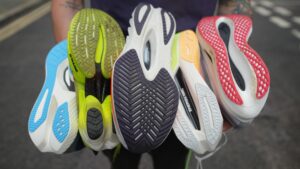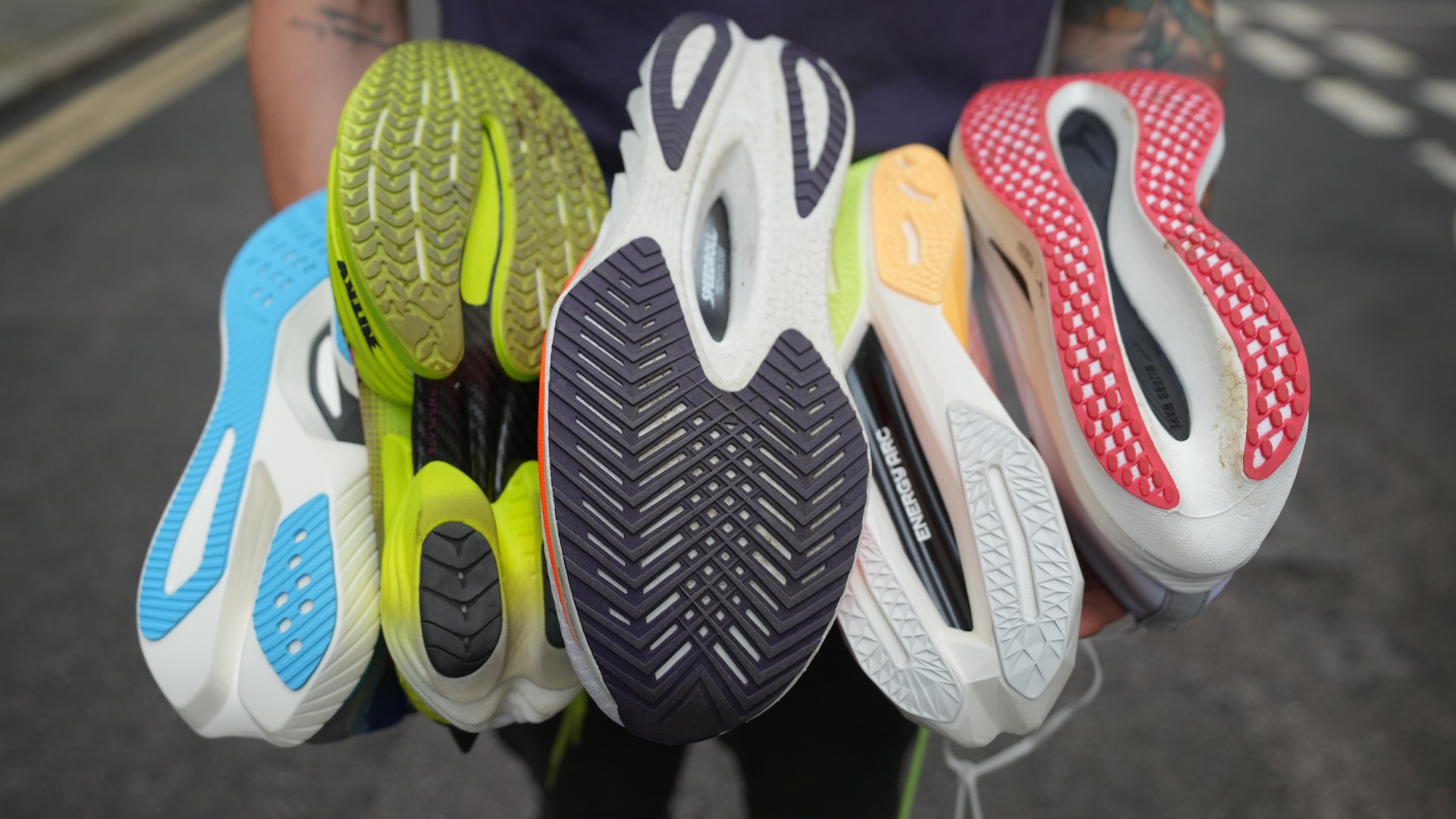Running has seen a revolution in recent years, largely propelled by advancements in footwear technology. At the forefront of this innovation are carbon plate running shoes. These aren’t just regular sneakers; they are specifically engineered tools designed to enhance speed and efficiency. Since their emergence, particularly sparking interest around elite marathon performances, carbon plate running shoes have become highly sought after by runners looking for an edge.

They promise faster times and a more economical stride. Understanding what these shoes are, how they work, and who can benefit from them is key. This detailed article explores the fascinating world of carbon plate running shoes, explaining the science, the benefits, and the considerations for runners at various levels.
What Defines Carbon Plate Running Shoes?
At their core, carbon plate running shoes combine two main elements that set them apart from traditional running footwear. First, they feature a stiff plate embedded within the midsole, typically made from carbon fiber.
Carbon fiber is chosen for its high strength-to-weight ratio and rigidity. Second, they often incorporate a significant amount of lightweight, highly resilient foam in the midsole. This foam is frequently thicker than in older shoe designs and is engineered for maximum energy return.
Traditional running shoes usually rely on foam alone for cushioning and energy absorption. While some might have plastic shanks for stability, a full-length or partial carbon fiber plate is a distinct feature of this new category. The combination of the rigid plate and the advanced, compliant foam creates a unique system.
This system works together to alter the runner’s gait and improve mechanical efficiency. Consequently, the design fundamentally changes how the shoe interacts with the ground and the runner’s footstrike.
The Science Behind the Speed Boost
The performance benefits of carbon plate running shoes stem from several biomechanical principles working in concert. These shoes aren’t simply “bouncing” you forward; they are subtly altering your running mechanics to save energy.
Firstly, the carbon plate provides stiffness. This stiffness reduces the amount of energy lost when your foot bends at the metatarsophalangeal joints (where your toes meet your foot) during toe-off. Instead of the energy being absorbed by the flexing joint, the stiff plate helps to maintain the foot’s structure, allowing more energy to be returned. Think of it like a lever: a rigid lever is more efficient at transferring force than a flexible one.
Secondly, the thick, responsive foam works with the plate. When your foot lands, the foam compresses, absorbing impact. As you push off, this specialized foam quickly expands back to its original shape, returning a high percentage of the absorbed energy. This “energy return” feels like a propulsive sensation. Older foams absorbed more energy and returned less.
Thirdly, many carbon plate running shoes utilize a “rocker” geometry. The sole is curved, particularly towards the front. This shape encourages a smoother, more efficient roll from heel strike (or midfoot strike) to toe-off. The rocker design, combined with the stiff plate, helps move the runner’s center of mass forward efficiently. This further reduces the work required by the calf muscles and Achilles tendon, thus improving running economy.
In essence, the carbon plate provides a stable, leveraged platform, the foam offers high energy return cushioning, and the rocker geometry facilitates a faster transition through the gait cycle. Together, they reduce the metabolic cost of running at a given speed, which translates to improved efficiency and faster times for many runners.
Key Benefits for Runners
The primary draw of carbon plate running shoes is their proven ability to enhance performance. Scientific studies and countless race results demonstrate tangible benefits.
One significant advantage is increased running economy. This means you use less oxygen and energy to run at a specific pace. Over the course of a race, especially a marathon, this energy saving can make a substantial difference, allowing you to maintain speed longer or run faster for the same effort.
Another benefit is the potential for faster race times. The improved efficiency and propulsion contribute directly to increased speed. Many runners find that these shoes allow them to shave significant time off their personal bests, particularly over longer distances.
Furthermore, the high stack of responsive foam offers excellent cushioning. This can lead to a perception of reduced impact stress, potentially helping legs feel fresher during and after long runs or races. While research is ongoing, some runners report less muscle soreness when using these shoes.
The unique ride also provides a feeling of propulsion or “pop.” This sensation can be mentally motivating and help maintain a strong pace. Overall, the blend of propulsion, efficiency, and cushioning makes carbon plate running shoes a powerful tool for performance-oriented runners.
Who Should Consider Using Them?
While the technology is impressive, carbon plate running shoes are not necessarily the best choice for every runner on every run. They are specifically designed as performance tools.
Elite and competitive amateur runners training and racing frequently are the primary target audience. These athletes are often seeking marginal gains and are accustomed to highly specialized footwear. They typically use these shoes for key speed workouts, tempo runs, and races ranging from 5k to the marathon.
Runners with efficient form may benefit most. The aggressive geometry and stiffness can sometimes be challenging for runners with less developed form or pre-existing biomechanical issues. The shoe’s design encourages a specific type of forward momentum.
It’s also important to note that they are generally not recommended as everyday training shoes for easy runs or high-mileage accumulation. Their stiffness, unique ride, and higher cost make them less suitable for general training purposes compared to more traditional, durable daily trainers. Using them sparingly can also help preserve their effectiveness and potentially reduce the risk of adaptation-related issues.
If you are a recreational runner curious about trying them, consider using them for a goal race. Try them out gradually during a few faster training sessions beforehand to get used to the feel. They can offer a boost, but understanding their purpose is key.
Potential Downsides and Important Considerations
Despite their advantages, carbon plate running shoes come with potential drawbacks. Runners should be aware of these before investing.
The most obvious downside is the cost. These shoes are significantly more expensive than standard running shoes, often retailing for $200 or more. This represents a substantial investment for many runners.
Durability can also be a concern. While the carbon plate itself is durable, the lightweight, high-performance foams used are often less resilient than traditional EVA foams. They can pack out or lose their responsiveness more quickly, meaning the shoe’s peak performance life might be shorter than a standard trainer.
Stability is another factor. The high stack heights and often narrow bases of some models can make them less stable, especially for runners who need more support or who run on uneven surfaces. Runners prone to ankle rolls might find some models challenging.
Furthermore, switching to shoes with significantly different mechanics like carbon plates can alter stress patterns on the legs. Some runners report new aches or pains, particularly in the calves, Achilles, or feet, when first adapting to these shoes. It’s crucial to introduce them gradually into your training.
They are also not ideal for all types of runs. Their stiffness and aggressive geometry can feel awkward or uncomfortable at very slow paces. They are built for speed and forward momentum.
Choosing and Training with Carbon Plate Shoes
Selecting from the wide range of carbon plate running shoes available can be overwhelming. Different brands use varying plate shapes, foam types, and stack heights, resulting in distinct rides.
Trying on several models is highly recommended. What feels propulsive and comfortable to one runner might feel unstable or awkward to another. Pay attention to how the shoe feels during your natural stride, even if just walking around the store.
Consider the type of running you plan to do. Some shoes are designed for marathon distance, with maximum cushioning, while others are lighter and geared towards shorter races like the 5k or 10k.
Once you have a pair, incorporate them into your training wisely. Do not suddenly switch to them for all your runs. Start by using them for a few strides after an easy run, then progress to portions of tempo runs or interval sessions. This allows your body to adapt to the different mechanics and stress points. Save them primarily for your key workouts and races to maximize their performance benefits and lifespan. Listen carefully to your body and back off if you experience new or persistent pain.
The Future of Carbon Plate Technology
The development of carbon plate running shoes represents a significant leap in running footwear technology. Research continues into optimizing plate geometry, foam compounds, and shoe construction to further enhance efficiency and comfort while potentially addressing some of the current limitations.
It’s likely that elements of this technology might trickle down into more mainstream training shoes over time, perhaps in modified forms that offer some benefits without the extreme characteristics of the top-tier racing models. The focus remains on reducing the metabolic cost of running and helping runners achieve their best potential.
Carbon plate running shoes have undeniably transformed the running landscape, enabling performances once thought impossible. By combining stiff carbon plates with advanced, responsive foams and optimized geometry, they offer tangible benefits in terms of speed and running economy.
While they represent a significant investment and are best suited as a performance tool for races and specific workouts rather than everyday training, they provide a distinct advantage for runners looking to push their limits. Understanding the science, benefits, and considerations allows runners to make informed decisions about whether carbon plate running shoes are the right fit for their goals and training. Like any piece of high-performance equipment, they are best utilized thoughtfully and integrated into a well-rounded training plan.








